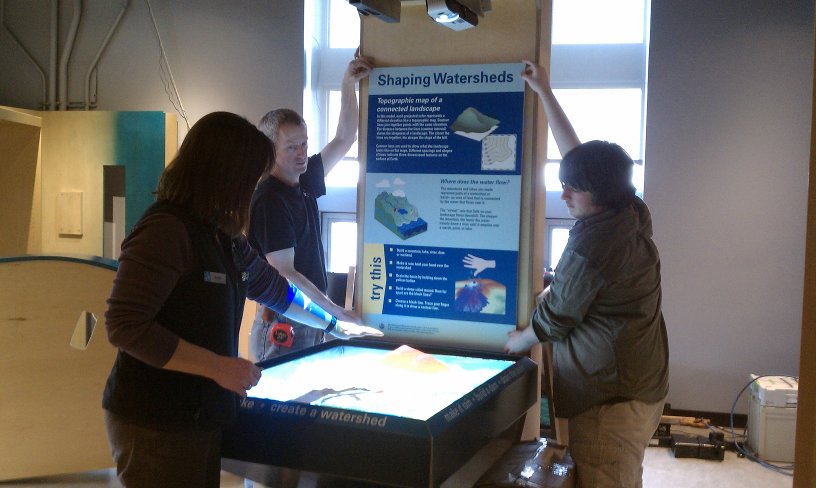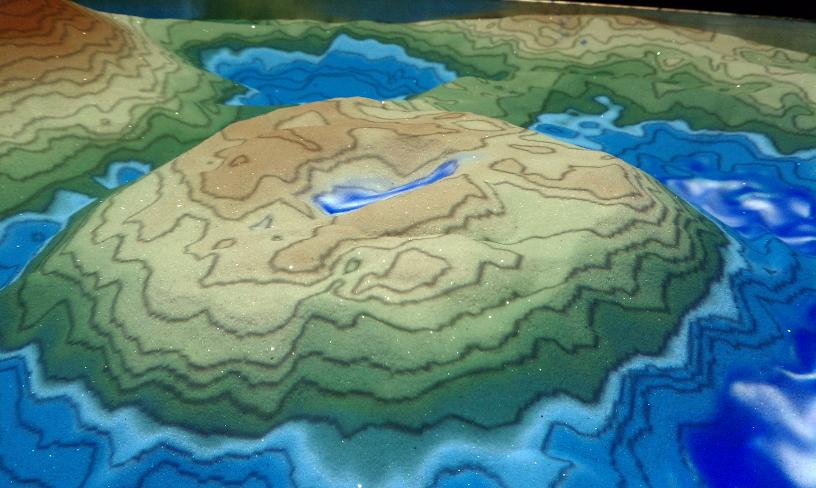The first “professionally built” AR sandbox, whose physical setup was designed and built by the fine folks from the San Francisco Exploratorium, arrived at its new home at ECHO Lake Aquarium and Science Center.

Figure 1: Picture of ECHO Lake Aquarium and Science Center’s Augmented Reality Sandbox during installation on the exhibit floor. Note the portrait orientation of the sand table with respect to the back panel, the projector tilt to make up for it, and the high placement of the Kinect camera (visible at the very top of the picture). Photo provided by Travis Cook, ECHO.
This is the first of three AR sandboxes to be installed as part of the NSF informal science education grant that funded creation of our sandbox software and the original hardware prototype. The remaining two sandboxes will be installed at their home institutions shortly.
As can be seen in Figure 1, the sandbox consists of a 40″x30″ welded steel sand table with a very cleverly designed catchment system for sand falling over the box edges, and a wooden cabinet / projector hood holding the driving computer (not at ECHO, though, where the computers are in an off-floor server room), the projector, and the Kinect. What’s a bit strange about this setup is that the sandbox is oriented portrait-wise with respect to the cabinet and hood, which means that the projector cannot be directly attached to the cabinet, but has to hang from the hood off to the side, and has to be tilted slightly to fully illuminate the sand surface. This was done to increase access to the sand table by exposing both long sides, but it doesn’t 100% work with the projector’s landscape image orientation. Also, the projector and Kinect are mounted rather high to keep them out of visitors’ head spaces, but that comes with a loss in resolution, because the Kinect has a fixed-focus lens. But it still works overall, demonstrating the flexibility of the driving software. That said, for DIY installations, I recommend hanging the Kinect camera lower, around 40″ above the sand surface (for a 40″ sandbox).

Figure 2: Close-up of sand table, with sand and virtual “water.” This is after a quick initial calibration between the (tilted) projector and the Kinect camera. Photo provided by Travis Cook, ECHO.
Figure 2 shows a close-up of the sand table after initial calibration, with sand already in it, and “water” added. The calibration, at this point, still needs some improvement, as can be seen in the close-up in Figure 3. Right now, there are elevation contour lines running up and down hills, which can be corrected by running a calibration procedure using more tie points.

Figure 3: Further close-up of sand table, showing subtle problems with the initial calibration. Elevation contour lines are not of constant elevation, but running up and down hills. This is due to a horizontal shift between the actual and projected sand surfaces, which can be fixed by applying a calibration using more tie points. Photo provided by Travis Cook, ECHO.

